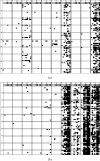Crystal cookery - using high-throughput technologies and the grocery store as a teaching tool
- PMID: 22184476
- PMCID: PMC3238385
- DOI: 10.1107/S0021889810027640
Crystal cookery - using high-throughput technologies and the grocery store as a teaching tool
Abstract
Crystallography is a multidisciplinary field that links divergent areas of mathematics, science and engineering to provide knowledge of life on an atomic scale. Crystal growth, a key component of the field, is an ideal vehicle for education. Crystallization has been used with a 'grocery store chemistry' approach and linked to high-throughput remote-access screening technologies. This approach provides an educational opportunity that can effectively teach the scientific method, readily accommodate different levels of educational experience, and reach any student with access to a grocery store, a post office and the internet. This paper describes the formation of the program through the students who helped develop and prototype the procedures. A summary is presented of the analysis and preliminary results and a description given of how the program could be linked with other aspects of crystallography. This approach has the potential to bridge the gap between students in remote locations and with limited funding, and access to scientific resources, providing students with an international-level research experience.
Figures











Similar articles
-
Remote laboratory training for high school students: grocery store based hands-on project in protein crystallography.J Appl Crystallogr. 2023 Aug 18;56(Pt 5):1557-1568. doi: 10.1107/S1600576723006805. eCollection 2023 Oct 1. J Appl Crystallogr. 2023. PMID: 37791367 Free PMC article.
-
The effectiveness of internet-based e-learning on clinician behavior and patient outcomes: a systematic review protocol.JBI Database System Rev Implement Rep. 2015 Jan;13(1):52-64. doi: 10.11124/jbisrir-2015-1919. JBI Database System Rev Implement Rep. 2015. PMID: 26447007
-
Student and educator experiences of maternal-child simulation-based learning: a systematic review of qualitative evidence protocol.JBI Database System Rev Implement Rep. 2015 Jan;13(1):14-26. doi: 10.11124/jbisrir-2015-1694. JBI Database System Rev Implement Rep. 2015. PMID: 26447004
-
Educational technologies and the teaching of ethics in science and engineering.Sci Eng Ethics. 2005 Jul;11(3):435-46; discussion 447-9. doi: 10.1007/s11948-005-0012-5. Sci Eng Ethics. 2005. PMID: 16190284 Review.
-
Grocery store access and childhood obesity: A systematic review and meta-analysis.Obes Rev. 2021 Feb;22 Suppl 1(Suppl 1):e12945. doi: 10.1111/obr.12945. Epub 2019 Oct 25. Obes Rev. 2021. PMID: 31650697 Free PMC article.
Cited by
-
From geology to biology: an interdisciplinary course in crystal growth.J Appl Crystallogr. 2022 Oct 1;55(Pt 5):1368-1376. doi: 10.1107/S1600576722008032. eCollection 2022 Oct 1. J Appl Crystallogr. 2022. PMID: 36249509 Free PMC article.
-
Crystals in the community and the classroom.J Appl Crystallogr. 2024 Feb 1;57(Pt 1):181-186. doi: 10.1107/S1600576724000207. eCollection 2024 Feb 1. J Appl Crystallogr. 2024. PMID: 38322722 Free PMC article.
-
Remote laboratory training for high school students: grocery store based hands-on project in protein crystallography.J Appl Crystallogr. 2023 Aug 18;56(Pt 5):1557-1568. doi: 10.1107/S1600576723006805. eCollection 2023 Oct 1. J Appl Crystallogr. 2023. PMID: 37791367 Free PMC article.
References
-
- Adlerova, L., Bartoskova, A. & Faldyna, M. (2008). Vet. Med. Czech. 53, 457–468.
-
- Astier, J. P. & Veesler, S. (2008). Cryst. Growth Des. 8, 4215–4219.
-
- Barab, S. A. & Hay, K. E. (2001). J. Res. Sci. Teach. 38, 70–102.
-
- Bosch, J. et al. (2006). J. Med. Chem. 49, 5939–5946. - PubMed
Grants and funding
LinkOut - more resources
Full Text Sources
Other Literature Sources
Miscellaneous
